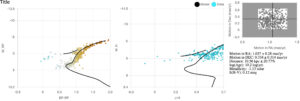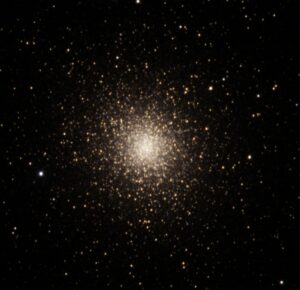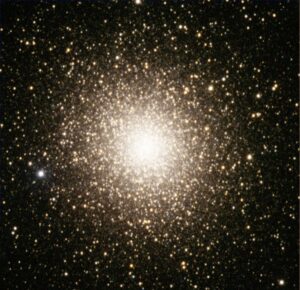Cluster NGC 2808: A Galactic Oddity – Blog by Annie Chikelu
Annie Chikelu
anc932
When we look up at the night sky, we can see countless stars twinkling in the darkness. However, some of these stars are not alone – they are part of star clusters, groups of stars that formed from the same cloud of gas and dust. One of the most intriguing of these clusters is NGC 2808, located in the southern constellation Carina, about 17,000 light-years away from Earth. It was discovered by James Dunlop, an astronomer from Scotland, in 1826. Globular clusters are among the oldest structures in our galaxy and contain some of the first stars to form after the Big Bang. NGC 2808 is particularly interesting because it contains multiple generations of stars with different ages and chemical compositions. NGC 2808 is a globular cluster, a type of cluster that contains hundreds of thousands of stars packed tightly together in a spherical shape. What sets NGC 2808 apart from other globular clusters is its unusual composition. While most globular clusters contain stars of a similar age, NGC 2808 has stars that span a wide range of ages, from 12 billion years old to as young as 1.2 billion years old. This diversity of ages has puzzled astronomers for decades. How could a cluster formed from a single cloud of gas and dust have stars so different in age? One possibility is that NGC 2808 underwent a series of mergers with other clusters throughout its history, which could have introduced new stars and mixed up the ages. Another possibility is that NGC 2808 is the product of a rare type of star formation known as multiple stellar generations. In this scenario, the cluster formed from a cloud of gas and dust that collapsed to form a first generation of stars. As these stars evolved and eventually died, they enriched the surrounding gas with heavier elements, which then collapsed to form a second generation of stars. This process could have been repeated multiple times, leading to the range of ages seen in NGC 2808. Despite decades of study, the origins of NGC 2808 remain a mystery. However, with the advent of new telescopes and instruments, astronomers are continuing to probe this enigmatic cluster in search of answers. NGC 2808 has been the subject of many research papers and articles, including a recent study by Milone et al (2021) which used the Hubble Space Telescope to study the cluster’s multiple stellar populations. While the mystery of NGC 2808 may not be solved anytime soon, it serves as a reminder of our galactic neighbourhood’s incredible diversity and complexity.
To study NGC 2808, I collected 15 exposure images using the Skynet robotic telescope network, PROMPT-MO-1, PROMPT2, and PROMPT5 with a total exposure time of 128s in three different filters (B, V, R). Afterglow and Cluster Pro Plus software processed and analyzed the images. In my analysis, I estimated the motion in RA to be 1.057 ± 0.28 (mas/yr), Motion in DEC to be 0.334 ± 0.314 (mas/yr), Distance to be 10.56kpc ± 20.77%, log (Age) to be 10.2log(yr), Metallicity to be -1.13 solar, and E(B-V) to be 0.12 mag. The cluster’s colour-magnitude diagram shows a clear separation between its different generations of stars, with the older stars being redder and fainter than the younger ones. One interesting finding from my analysis is the presence of blue straggler stars in NGC 2808. Blue stragglers are stars that appear younger and more massive than their surroundings and are thought to form from the collision or merger of two or more stars. The presence of blue stragglers in NGC 2808 suggests that the cluster has undergone a complex history of interactions and mergers. Another notable feature of NGC 2808 is its lack of a central concentration of stars, which is typically seen in globular clusters. This suggests that NGC 2808 may have undergone a core-collapse event in the past, where the central region of the cluster became more tightly packed and unstable.
OBSERVATIONS WITH IMAGES


This is my dereddened image for NGC2808. Using my estimated E(B-V) value.

The image above is an image of NGC2808, I grouped my B, V and R images together and then set the colour map to the correct colours and edited using afterglow. This image is not DE-reddened.
In conclusion, Studying NGC 2808 has been a truly enriching experience. This fascinating globular cluster, with its multiple generations of stars and unique features, has provided us with a glimpse into the complex history of star formation and evolution in our galaxy. The presence of blue stragglers, the lack of a central concentration of stars, and the confirmation of previous studies have all contributed to our understanding of how clusters form and evolve over time. Exploring the mysteries of the universe and uncovering new insights is not only enjoyable but also crucial to our continued scientific advancement. NGC 2808 serves as a reminder of the endless possibilities for discovery and education that the cosmos holds.
References:
Milone, A. P. et al. (2021). Multiple populations in NGC 2808. Astronomy & Astrophysics, 650, A51. doi: 10.1051/0004-6361/202140682
Wiki on NGC 2808